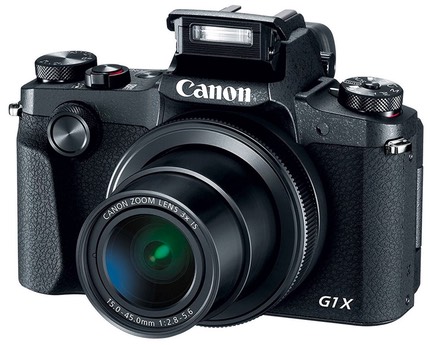
Canon today announced the PowerShot G1 X Mark III, their high-end compact camera with an APS-C sensor. By all appearances, this is the same dual-pixel 24mp sensor used in the M series, the SL, and in some of the DSLRs.
In front of the sensor is a 24-72mm (equivalent) f/2.8-5.6 lens, and that lens focuses down to 4" (10cm) at the wide end, 3x that at telephoto, so modestly macro. At the back end we have a .39" 2.36m dot EVF and a 3" 1.04m dot touch/full swivel LCD (left hinge). Video is specified at 1080P/60 tops, and continuous shooting with focus is 7 fps (9 fps without).
All the usual other goodies are included, particularly Bluetooth, NFC, and Wi-Fi. Battery used is the NB-13L, which produces a measly 200 shots CIPA. There's a three stop ND available internally, and the lens is image stabilized (4 stops CIPA). The whole package weighs in at 14.1 ounces (399g). Price is US$1299 and the camera should be available sometime in November.
The G1 X Mark III is a bit of an ugly duckling. The proportions don't look right, with a large EVF+flash up top and the declining size, multi-stage power zoom lens looking very odd together. It's also unclear why the right hand grip is as shallow as it is, given that the collapsed lens still sticks out further.
I like Canon's strategy here, though, while I also don't like it. Let me explain.
The part that strikes me as 100% correct is the re-use of sensors while giving shooters their choice of camera type/style to use that sensor in. If I'm looking for Canon's 24mp APS-C level of quality, I can get it in quite a range of cameras now (compact, mirrorless, multiple levels of DSLR). That is dead on correct strategy as far as I'm concerned. Don't force the user to buy an ILC if they want a compact, or a mirrorless if they want a DSLR, or any other combination of two. Let the user decide what they buy. After all, it's still a sale to Canon.
Where Canon's strategy starts to fall apart is in the details. The EOS M5 is US$1099 with the kit lens that (mostly) matches the G1 X Mark III, which for some reason is US$200 more. The weights are within .9 ounces of one another (28g), and the sizes are similar other than the height (the M5 stands taller).
But curiously, the controls are completely different. The cheaper camera (EOS M5) has the better controls and a better shutter. The cheaper camera has a better LCD, though an inferior swivel. The cheaper camera gets more shots per battery charge. It's almost as if the compact camera chooser is being penalized for some strange reason.
I have to wonder if there's dissension within the engineering teams at the big companies like Canon. The G1 X Mark III designers seem insistent upon using their ugly front-of-body dial that is totally unergonomic, while the EOS M5 designers came up with an almost Nikon-like approach of opposing front/rear dials, while the DSLR designers are sticking with the vertical front dial behind the shutter release and the rear dial being around the Direction Pad.
That's wrong. Totally wrong. Pick a style and stay with it. As I've written many, many times, serious photographers own multiple cameras. We hate it when those cameras have different ergonomic designs and we have to think about which camera we have in our hands and what controls do what.
Moreover, there's the "learnability" factor. If you're hooking someone in at the bottom of your lineup (GX, EOS M) and then move them up a step or two, the controls and options shouldn't be different as they go to more sophisticated cameras. There should simply be "more controls and more options and better performance."
So, two things Canon's going to have to explain to me about the new G1 X: (1) pricing; and (2) why all the different ergonomic approaches?